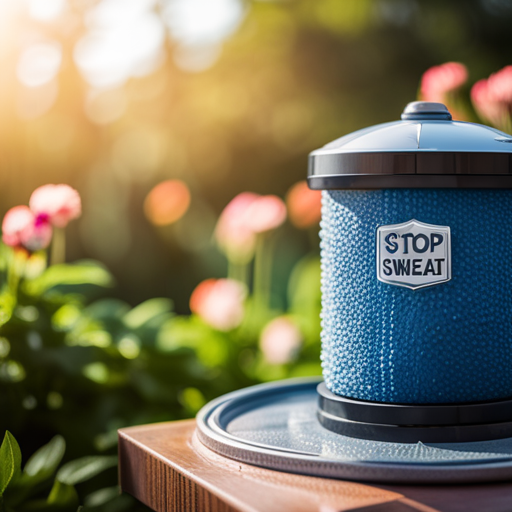Are you experiencing puddles around your water softening system? Are you noticing mold or structural damage in your home? You may be dealing with sweating pipes due to condensation caused by your water softener.
But don’t worry, there are steps you can take to stop sweat and protect your water softener, ensuring the safety of your home and family.
In this article, we’ll guide you through the causes of sweating pipes, the health and safety risks associated with it, and the preventative measures you can take to avoid future problems.
By identifying the signs of sweating and differentiating between sweat and leaks, you can take the necessary steps to protect your water softening system from damage and ensure its longevity.
So, let’s dive in and learn how to stop sweat and protect your water softener.
Key Takeaways
– Sweating pipes can be caused by high humidity levels, poorly insulated pipes, air conditioning unit, cooking, and showering.
– Signs of sweating pipes include puddles around water softening system, mold, and structural damage which can lead to fire hazards.
– Preventative measures such as keeping the area clean and dry, using a dehumidifier, and insulating pipes with neoprene or foam sleeves can help stop sweating pipes.
– It’s important to monitor humidity levels to keep them between 30 to 50 percent to prevent sweating and mold growth, and to regularly maintain the system to prevent issues. Mold can cause health issues and structural damage, so calling a professional plumber or electrician is recommended if signs of mold growth or electrical hazards are noticed.
Causes of Sweating Pipes
If your water softener is sweating, it may be due to condensation caused by high humidity levels. When the air around the pipes is too humid, it can cause water droplets to form on the surface of the pipes, which can lead to puddles and mold growth. This can be a serious problem, as mold can cause health issues and structural damage to your home.
Condensation sources can come from a variety of places, including your air conditioning unit, poorly insulated pipes, and even cooking and showering. When hot, humid air comes into contact with a cooler surface, like your water softener pipes, it can cause condensation to form.
The amount of sweat also depends on the temperature of the surrounding air. If you live in an area with high humidity levels, it’s important to keep your home’s humidity levels between 30 to 50 percent to prevent sweating pipes.
Health and Safety Risks
To ensure your safety and prevent potential health hazards, it’s important to address any moisture or mold growth around your water softening system. Mold can cause respiratory problems, allergies, and even death in severe cases. Additionally, sweating pipes can create a fire hazard if water droplets fall onto exposed electrical wiring.
Here are some ways you can prevent mold growth and electrical hazards around your water softening system:
– Keep the area around your water softener clean and dry. Wipe down any surfaces that appear wet or moist.
– Use a dehumidifier to keep the air around your water softener dry. This will help prevent the growth of mold and mildew.
– Use a fan or vent to circulate air around your water softener. This will help prevent moisture buildup.
If you notice any signs of mold growth or electrical hazards, call a professional plumber or electrician right away. They can assess the problem and recommend the best course of action.
Preventative Measures
Maintain a dry and clean environment around the water softening system to prevent mold growth and potential electrical hazards. To avoid sweating pipes, consider insulating them with neoprene or foam sleeves. These sleeves can be custom-made or self-made and easy to install. They are an effective way to permanently stop sweating by blocking condensation. Additionally, it’s important to monitor the humidity levels in the room where the water softening system is located. Humidity levels should be between 30 to 50 percent to prevent sweating.
Regular maintenance is also crucial in preventing sweating pipes and mold growth. Wipe down the pipes often to determine if it’s sweat or a leak. If it’s mold, use a mixture of soap and water or bleach to remove it. However, safety precautions should be taken when dealing with mold. Small puddles of water can be mopped up with towels. Finally, if you notice a sudden increase in your water bill, it could indicate a leak within the system, which could lead to severe problems and require a plumber. By taking these preventative measures, you can protect your water softening system and ensure a safe and healthy environment for you and your family.
| Insulation Options | Pros | Cons | Recommended for… |
|---|---|---|---|
| Neoprene Sleeves | Effective, easy to install | Can be expensive | Pipes that are easily accessible |
| Foam Sleeves | Affordable, easy to cut to size | Less effective than neoprene | Pipes in tight spaces |
| Fiberglass Insulation | High insulation value | Difficult to install, can release harmful fibers | Experienced DIYers only |
| Reflective Insulation | Effective, reduces heat transfer | Expensive | Extremely hot environments |
Conclusion
Now that you understand the causes and risks of sweating pipes in your water softening system, it’s time to take action. By implementing preventative measures such as using neoprene or foam sleeves, you can protect your system and avoid future problems.
Keep an eye out for signs of sweating, such as puddles or mold, and differentiate between sweat and leaks to prevent structural damage and health risks. Remember, taking care of your water softening system not only ensures its longevity but also the safety of your home and loved ones.
Don’t let sweating pipes go unnoticed and address the issue promptly. With these tips in mind, you can stop sweat and protect your water softener for years to come.




